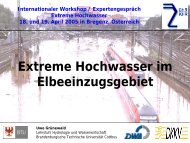ABSTRACTS 'Extreme Discharges' - CHR-KHR
ABSTRACTS 'Extreme Discharges' - CHR-KHR
ABSTRACTS 'Extreme Discharges' - CHR-KHR
You also want an ePaper? Increase the reach of your titles
YUMPU automatically turns print PDFs into web optimized ePapers that Google loves.
Hydra-Models, a way to assess the influence of climate<br />
change and river programs on future dike heights and the<br />
probability of dike failure.<br />
Robert Slomp<br />
Institute for Inland Water Management and Waste Water Treatment (RIZA)<br />
P.O. Box 17, NL 8200 AA Lelystad, the Netherlands<br />
r.slomp@riza.rws.minvenw.nl<br />
The use of Hydra-models is mandatory in the Netherlands for verifying the minimum safety levels of primary<br />
flood defences in the deltas of the Rhine and Meuse and in the IJssel lake area. Hydra-models can also be used<br />
in policy studies, the outcome of large river projects can be evaluated in combination with climate change. This<br />
paper will cover the possibility to assess the combined influence of climate change and river programs on future<br />
dike heights and the chance of dike failure. In this way a robust strategy can be determined. Realistic examples<br />
of climate change and project proposals can be combined.<br />
Flood defences have been built to accommodate for the two major threats, high discharges and storm. Storms<br />
generate storm surges and waves but also impede drainage, so combinations of high water levels and waves<br />
threaten dikes. The largest estuaries have been closed off with storm surge barriers. However the locally built up<br />
storm surges to the land side of the storm surge barriers in combination with the impeded drainage remain a<br />
threat. In the IJssel lake area, at the mouth of the IJssel these storm surges amount up to 2 m and in the lower<br />
reaches of the Rhine and Meuse up to 50 cm. Impeded drainage to the sea, because of storm surges, adds between<br />
1 m to 2,5 m to the water levels at design conditions, especially in the closed off estuaries Haringvliet and<br />
Hollandsch Diep. At the moment two large river projects are being prepared Room for the River (Ruimte voor<br />
de Rivier) and the Meuse works, (de Maaswerken), these projects will be finished in 2015. A number of studies<br />
on the impact of climate change on design water levels have been published. But up till now no studies combine<br />
both issues, the influence these large projects and climate change, on necessary dike heights in a detailed and<br />
precise manner for all stretches of the Rhine and Meuse rivers.<br />
The main purpose of the Room for the River project is to accommodate for the difference in official design water<br />
levels caused by the high river discharges of 1993 and 1995. The Room for the River project mainly lowers<br />
design water levels on the Rhine Branches and lower Meuse (from Meuse km 201 to km 250) where the design<br />
water levels are primarily caused by high discharges. The project consists of increasing the discharge capacity<br />
of the river by enlarging the cross section. In the short term dikes will be laid back, side channels dug, river<br />
groins lowered. In some areas dike reinforcement will be inevitable, especially where the river is no longer the<br />
predominant threat but combinations of storm and river discharges are. On account of climate change large scale<br />
measures are being considered as measures for the long term e.g. flood retention reservoirs and bypasses<br />
through existing polders.<br />
The Meuse works mainly improve the safety for people living in the Meuse flood plain, by lowering the design<br />
water levels, by raising the existing levees and by the construction of a number of flood retention reservoirs.<br />
The return period for the levees, built in 1995-2000, will be raised from 50 years to 250 years. In fact the river<br />
cross section has been diminished for most discharges, except for the design discharge of the Meuse, which has<br />
a return period of 1250 years. The Meuse Works have to compensate for these negative effects, no rise in design<br />
water levels downstream of the project area is permitted, from km 150 to 250.<br />
The Hydra-models calculate<br />
- The exceedence frequency of a fixed level of the hydraulic load. This fixed level can be the design water<br />
level or the dike height of a dike section or enclosed combination of dike sections, called a dike ring.<br />
- The design water level or design height of a dike can also be determined for an exceedence frequency<br />
or return period.<br />
- The wave overtopping rate for a given dike height and return period.<br />
The Hydra-models make it possible to evaluate a certain project proposal in detail in a situation with and without<br />
climate change. Up till now the possibility to assess the combined influence of climate change and river<br />
programs on future dike heights and the chance of dike failure is only possible on the Rhine branches and the<br />
69





